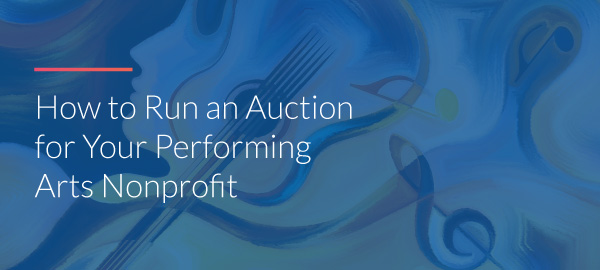
Running a successful auction for your performing arts nonprofit is a multifaceted endeavor, requiring meticulous planning and strategic execution. Whether your event is virtual, in-person, or a blend of both, the right tools and approach can turn your event into a memorable and profitable experience.
Start planning for your auction several months in advance, and be sure to document planning setbacks, discoveries, and opportunities. With this insight, you can create an action plan for running your most successful auction yet. Now, let’s dive into our top tips for hosting a performing arts auction.
Zero in on your audience.
As you start the planning process for your silent auction, it’s crucial to spend time getting to know your audience. After all, the amount of revenue you raise will depend on how much guests want to bid on your items—make sure you know what they want!
Research your target audience’s interests, preferences, and past engagement data to tailor your event and offerings accordingly. Explore the information in your donor or member database, and revisit feedback surveys from past events to see what strategies were most successful at engaging your guests. Consider questions such as:
- Which auction items were the most popular at past events?
- What items or experiences appeal to our audience?
- How can we enhance engagement during the event?
- Are there any recurring trends among past attendees?
- What marketing strategies effectively reach our target demographic?
- Are there any auction themes that would particularly interest our audience?
- What price range is reasonable for our audience?
- Who is likely to attend? Parents, families, or working professionals?
Use the answers to these questions as an informed jumping-off point for your auction planning process. Don’t underestimate an empathetic approach—it will undoubtedly strengthen relationships and maximize your auction’s fundraising potential.
Reach out to local businesses.
When you’re ready to solicit auction items for your event, start by asking local businesses to donate. Collaborating with local businesses can significantly enhance your auction catalog and help you cultivate lasting relationships. Follow these steps for successful partnerships:
- Research businesses before approaching them. Get familiar with each business’s services, giving history, and philanthropic values.
- Reach out to medium and low-priority sponsors first. Your procurement team will get better at making your pitch to sponsors with more experience. Starting small will allow them to refine their presentation in lower-stress situations.
- Present multiple support options. Present a variety of sponsorship options to accommodate different budgetary constraints. For example, some businesses may only be able to donate a gift card to their store while others can provide catering services for your entire event.
- Encourage businesses to attend the event. If they can’t donate or support financially, extend an invitation. Their presence adds to the guest list of potential bidders and strengthens your nonprofit’s relationship with the business.
- Highlight the benefits of sponsorship. 360MatchPro’s guide to corporate philanthropy explains that businesses that sponsor nonprofits can see increases in employee engagement, their reputation in their community, and their overall work environment. Call out these benefits to attain more sponsors.
Remember that even if you don’t secure auction items from a business, the effort is still worthwhile. Just by reaching out, you’ll begin a relationship with them and open the door for future support.
Invest in necessary software.
In today’s landscape, utilizing the right software is essential for streamlining auction management and enhancing the participant experience. Whether you’re hosting an in-person, hybrid, or virtual auction, consider investing in these tech tools to host a better event:
- Auction software. Many auction platforms include features to create online item catalogs, facilitate remote bidding, and improve event communication, all of which help you provide more engagement opportunities for your guests.
- Mobile bidding apps. Some silent auction apps have mobile bidding features that allow guests to bid from anywhere using their phones. Bidding with the tap of a button instead of fighting with paper bid sheets saves time and frustration for both attendees and your team.
- A CRM. Auctions generate a lot of donor data, such as event attendance and donations made, which can be leveraged for future fundraising campaigns. Make sure you have a database ready to store this important information.
- Text-to-give tools. These tools allow guests to donate just by texting. Promote your text-to-give number through announcements, displays at the venue, and online marketing. Plus, seeing others pull out their phones to give will encourage a little giving peer pressure.
Make sure to train your staff and volunteers on how to effectively use your software solutions. By providing them with thorough training, your staff will be more confident, you’ll get the most bang for your buck, and your events will be that much better. This will also showcase your staff’s proficiency and enhance their credibility as auctioneers, ultimately leading to increased guest satisfaction and future fundraising opportunities.
Market your auction.
Once you have the auction items and technology covered, you can start planning your marketing strategy. Promote your event across multiple channels to establish a variety of touchpoints, and leverage data to better target your audience.
For instance, you might analyze the communication preference data in your CRM and see that many past attendees like to hear from your nonprofit on social media. With this insight, you could create promotional posts on multiple social media outlets to spread the word about your auction.
As you promote your auction and highlight high-value items, make sure to maintain a consistent brand identity so your organization is easily recognized. Additionally, consider using your nonprofit’s network of business connections to help promote your event. When you post on social, tag or collaborate with the business that provided the item to increase your reach.
Highlight your nonprofit’s mission throughout the auction.
Auctions are exciting events, and guests can get so caught up in bidding on items that your mission falls by the wayside. Make sure to tie your mission into different parts of the event to make a lasting impression on guests. For instance, you might:
- Share blog articles, emails, and social media posts that talk about your mission.
- Make announcements or speeches periodically about your upcoming initiatives.
- Create displays for the event that talk about your nonprofit’s history and mission.
- Host cause-relevant activities during the event, such as a meet-and-greet with your founder.
- Invite a volunteer, board member, or beneficiary to speak about your nonprofit’s impact on their life.
By emphasizing your mission throughout the event, guests may be moved to give more. Plus, after your events, guests will likely spread the word about your mission and not just the items they won.
Follow up with guests and sponsors afterward.
Remember, your auction isn’t just a fundraiser—it’s also an opportunity to help build connections and create relationships with long-standing supporters. To cement these new connections, don’t forget to follow up and thank them for attending after the auction ends.
We suggest including the following in your follow-up messages:
- A sincere thank you. For most supporters, thank-you letters, cards, and phone calls feel more personal than a thank-you email. Go the extra mile to show your appreciation, especially for sponsors and notable donors.
- An impact statement. Share concrete data about what you accomplished with guests’ contributions. Provide the total amount raised, and share something your nonprofit was able to do with the auction’s proceeds.
- A personalized address. Personalize your follow-up messages by addressing each guest and sponsor by name and including relevant details about their contributions to your auction.
- A post-event survey. This will help your organization evaluate your success and plan for the next event. Try to keep it short and sweet, and include open-ended questions in addition to multiple choice so you get as much feedback as possible.
Think of your follow-up process as an investment in your nonprofit’s future. Guests and sponsors who had a positive experience are likely to return for upcoming fundraisers, especially if they receive an invitation in your follow-up messages.
Auctions are complex fundraisers, but they’re also highly impactful when you run them successfully. With the right team and resource investment tied with these guidelines, you can make your performing arts auction a smooth, memorable hit!
Author: Jeff Porter, CEO of Handbid
Jeff is no stranger to fundraising events, having participated in them for over 25 years. He ran his first fundraiser in 2005 and has managed over 50 auction events and fundraisers for his own charities, not to mention hundreds more with Handbid. Jeff has been involved in technical product and software development since 1996 and has built and managed mobile app solutions since 2008. When it became clear that he and his wife, Kari Porter, needed a better solution for their fundraisers, developing a mobile bidding app was a no-brainer. The result? Jeff and his wife Kari developed and launched Handbid in 2011. The rest is what they call “history”
